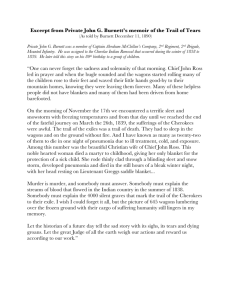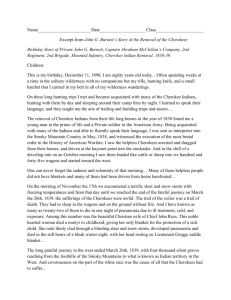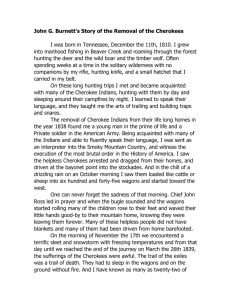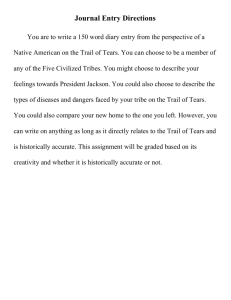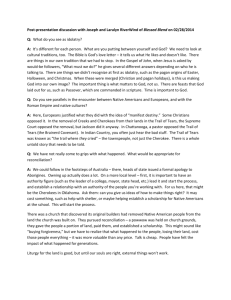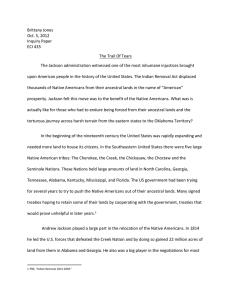Summarize the perspective (view)
advertisement
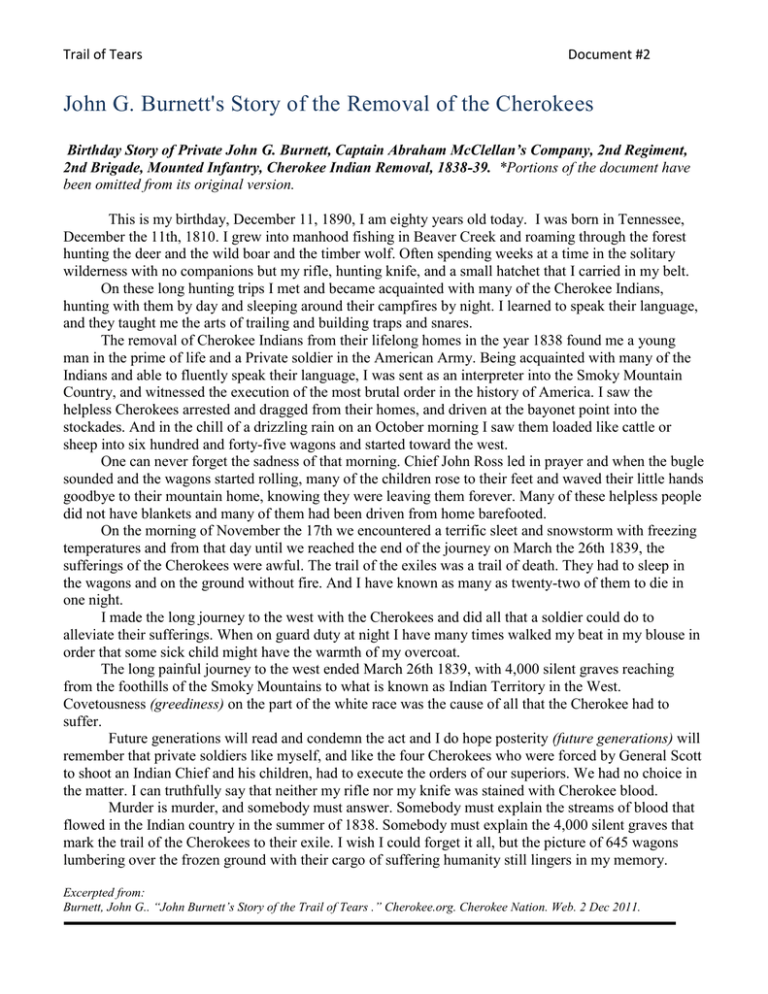
Trail of Tears Document #2 John G. Burnett's Story of the Removal of the Cherokees Birthday Story of Private John G. Burnett, Captain Abraham McClellan’s Company, 2nd Regiment, 2nd Brigade, Mounted Infantry, Cherokee Indian Removal, 1838-39. *Portions of the document have been omitted from its original version. This is my birthday, December 11, 1890, I am eighty years old today. I was born in Tennessee, December the 11th, 1810. I grew into manhood fishing in Beaver Creek and roaming through the forest hunting the deer and the wild boar and the timber wolf. Often spending weeks at a time in the solitary wilderness with no companions but my rifle, hunting knife, and a small hatchet that I carried in my belt. On these long hunting trips I met and became acquainted with many of the Cherokee Indians, hunting with them by day and sleeping around their campfires by night. I learned to speak their language, and they taught me the arts of trailing and building traps and snares. The removal of Cherokee Indians from their lifelong homes in the year 1838 found me a young man in the prime of life and a Private soldier in the American Army. Being acquainted with many of the Indians and able to fluently speak their language, I was sent as an interpreter into the Smoky Mountain Country, and witnessed the execution of the most brutal order in the history of America. I saw the helpless Cherokees arrested and dragged from their homes, and driven at the bayonet point into the stockades. And in the chill of a drizzling rain on an October morning I saw them loaded like cattle or sheep into six hundred and forty-five wagons and started toward the west. One can never forget the sadness of that morning. Chief John Ross led in prayer and when the bugle sounded and the wagons started rolling, many of the children rose to their feet and waved their little hands goodbye to their mountain home, knowing they were leaving them forever. Many of these helpless people did not have blankets and many of them had been driven from home barefooted. On the morning of November the 17th we encountered a terrific sleet and snowstorm with freezing temperatures and from that day until we reached the end of the journey on March the 26th 1839, the sufferings of the Cherokees were awful. The trail of the exiles was a trail of death. They had to sleep in the wagons and on the ground without fire. And I have known as many as twenty-two of them to die in one night. I made the long journey to the west with the Cherokees and did all that a soldier could do to alleviate their sufferings. When on guard duty at night I have many times walked my beat in my blouse in order that some sick child might have the warmth of my overcoat. The long painful journey to the west ended March 26th 1839, with 4,000 silent graves reaching from the foothills of the Smoky Mountains to what is known as Indian Territory in the West. Covetousness (greediness) on the part of the white race was the cause of all that the Cherokee had to suffer. Future generations will read and condemn the act and I do hope posterity (future generations) will remember that private soldiers like myself, and like the four Cherokees who were forced by General Scott to shoot an Indian Chief and his children, had to execute the orders of our superiors. We had no choice in the matter. I can truthfully say that neither my rifle nor my knife was stained with Cherokee blood. Murder is murder, and somebody must answer. Somebody must explain the streams of blood that flowed in the Indian country in the summer of 1838. Somebody must explain the 4,000 silent graves that mark the trail of the Cherokees to their exile. I wish I could forget it all, but the picture of 645 wagons lumbering over the frozen ground with their cargo of suffering humanity still lingers in my memory. Excerpted from: Burnett, John G.. “John Burnett’s Story of the Trail of Tears .” Cherokee.org. Cherokee Nation. Web. 2 Dec 2011. Trail of Tears Document #2 Thought Questions: 1. What was Burnett’s relationship with the Cherokee prior to being assigned as an interpreter? 2. What does Burnett reveal about his feelings toward the Trail of Tears? 3. What do you think about Burnett’s defense that he “had to execute the orders of our superiors?” 4. What does Burnett mean by “4,000 silent graves?” You have read two perspectives of the Trail of Tears. Complete the activity below to develop your perspective. Please provide thoughtful and thorough responses. Summarize the perspective (view) of . . . John Burnett: Samuel Cloud: If you could, what would you say to . . . John Burnett: Samuel Cloud:
